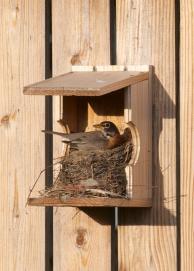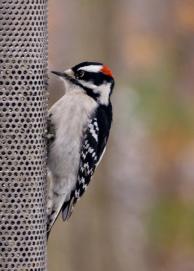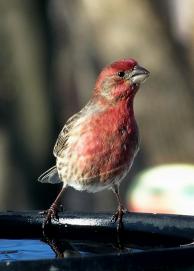Northern Cardinal

What was the first bird you can remember learning? For many of us it was the Northern Cardinal (Cardinalis cardinalis). The bright red plumage of the male with its tall crest and large orange bill make it one of the most identifiable birds in the world. Primarily a southern species, the “Cardinal Grosbeak”, as it was once known, is a resident now in all but a few northwestern states. Milder winters and urbanization have enabled the cardinal to expand its range over the last century. In other words, cardinals have adapted quite well to human disturbance.
In their natural habitat, cardinals prefer woodland edges where they can find a wide variety of seed and berry producing plants. One of the grosbeaks, their large bills allow the cardinal to tackle seed coats that many smaller birds struggle with. The male’s bright plumage makes them vulnerable to predators. This explains why we see so many cardinals in our backyard right at sunset. When you are bright red, shadows and low light levels are your friend, especially in a bleak or snow covered winter landscape.
Males begin singing their spring songs as early as February in an effort to attract a mate for the season. For most birds, it is the male who does all of the singing, but female cardinals do join in for a duet from time to time and even sing from the nest. Both male and female also defend their nesting territories quite aggressively as is demonstrated by them repeatedly banging into a window or car mirror trying to chase away the rival they see in the reflection.
I have found cardinal nests in many different locations. As a rule, they like a thick small tree or shrub. One fond memory is a pair nesting in a fairly open dogwood just outside a bedroom window a few years ago. The female’s drab brown plumage with red highlights is far better suited for blending into the nest duties she incurs. The 3 to 4 eggs she lays take about 12 days to hatch and another 12 days to fledge.
Fixtures in backyards in our area, cardinals are easily attracted to a bird feeder stocked with sunflower and safflower seed. Those who have trouble attracting them generally have very open yards lacking the thicker shrubs they like for escape and nesting cover.
Mark's Spotlight
-

American Gold Finch
Read more about the American Goldfinch -

American Robin
Read more about the American Robin -

Black-Capped Chickadee
Read more about the Black-Capped Chickadee -

Downy Woodpecker
Read more about the Downy Woodpecker -

House Finch (Male)
Read more about House Finch -

Northern Cardinal
Read More about Northern Cardinal
Shop Now!
-
Mark's No-Waste Blend™
Regular price From $15.99 USDRegular price -
Boardwalk Blend™
Regular price From $8.99 USDRegular price -
NP1009 OrioleFest
Regular price $29.99 USDRegular price -
Multi-Seed Tube Feeders w/Quick-Clean® Bases
Regular price From $59.99 USDRegular price











